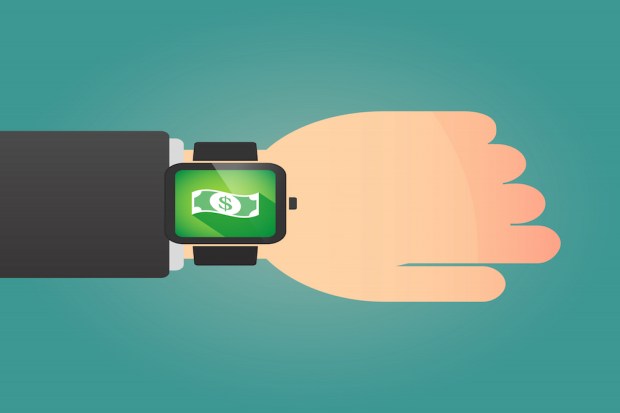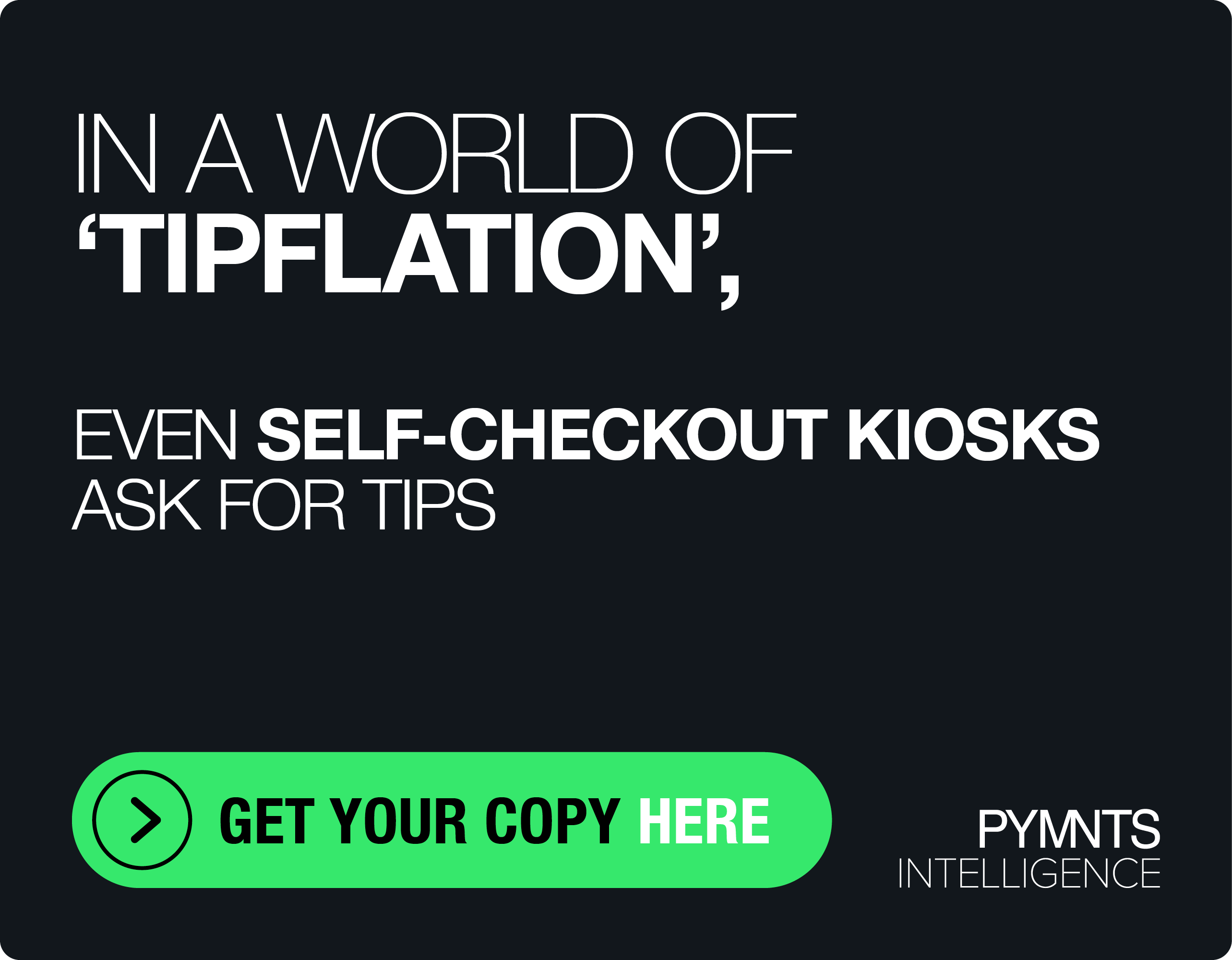Shock Value Or Actually Valuable? New IoT Banking Platform Zaps Out

The holy grail is making payments invisible – right? Maybe not so much for consumers trying to maintain budgets. PYMNTS’ May Internet of Things Tracker features an interview with David Webber, Managing Director Intelligent Environments, about how the company is using IoT to help power some, shall we say, “shocking” and buzzworthy technologies to keep consumers from going astray. The Tracker also includes a player directory of 71 companies, featuring 10 new additions.
It was, perhaps, only a matter of time.
With today’s market brimming with smart payment solutions that are making it increasingly easier for consumers to conduct seamless transactions in stores, at home and on the go – it’s also arguably become easier for consumers to spend without fully considering the consequences. With the convenience of digital and card-based payments comes a higher risk of overspending. After all, finances that are out of sight are out of mind, which can make consumers feel wholly out of control when it comes to fiscal planning.
According to David Webber, Managing Director at U.K.-based digital financial solutions company Intelligent Environments, today’s financial fluidity contributes to a sense of powerlessness among spenders.
“Money is becoming more and more invisible as people use things like Apple Pay, or they have regular payments leaving their bank account,” Webber said. While this is inherently convenient, it can lead to a mental disconnect, he said. “They are not taking a week’s worth of cash out of the teller machine and seeing everything leaving their wallet or purse. There’s money going in all sorts of direction and all sorts of ways and a lot of people are feeling disconnected from their money,” he said.
Enter Intelligent Environments’ new IoT banking platform, called Interact IoT, which the company is touting as the “the world’s first Internet of Things bank platform.” This digital financial technology, which allows users to link their bank accounts with various smart devices, is at the forefront of financial interconnectivity. In an attempt to empower accountholders with more scrutiny over their own resources amidst increasingly invisible and seamless transactions, Webber and his team integrated a feature to Interact IoT that is, in fact, shocking.
PYMNTS.com caught up with Webber on the heels of his company’s platform announcement to discuss the future of connected technology and how Intelligent Environments is using IoT to power cutting-edge financial solutions.
A shocking rollout
As part of their IoT banking platform initial rollout, Intelligent Environments integrated the Pavlok wristband, a wearable interconnected device that “delivers an electric shock” to users’ wrists when they exceed predetermined spending, for example. So a user who sets a limit of $1,000, for example, will receive shock if they spend more than this amount.
The shock is in fact an electric shock – not just a splashier synonym for buzz or vibrate. The customizable technology enables wearers to create their own financial plans via a mobile app, in which they can also set the intensity of their physical alert: a vibration, buzz or shock ranging on a scale from one-to-10.
The concept of using wearable technology to eradicate bad habits is nothing new (think anti-snoring devices that claim to wake noisy sleepers and fitness bracelets that encourage users to keep active and lose weight). Pavlok’s connection to the IoT banking platform, however, makes it part of a wider push toward comprehensive cross-platform integration.
Webber said the company has seen interest from some of their consumer finance and retail banking clients, but as of this writing they have not signed an agreement yet.
Intelligent Environments has also connected Interact IoT to the Nest Thermostat, a widely adopted smart-home device that automatically turns down users’ home heating to help them save on their monthly bills. Webber explained that both money-saving devices were created by harnessing the power of recognizable solutions, like bracelet-style wearables and home thermostats, and leveraging them via IoT technology.
“We took a piece of existing off-the-shelf technology, and then we take our banking platform. Within our banking platform, we build a user interface for the Pavlok device and then demonstrate that you can configure the app on your smartphone,” he said. “And if my balance drops to this particular level then I want to be alerted, and if it drops below this level then I want to be buzzed at this level of intensity. Then, just by using the Internet of Things and connecting over the Internet, the two devices are integrated and reacting – the activities of one area is being reacted to by the other device. So this is taking sets of existing technologies and demonstrating the use of the Internet of Things to make them communicate with each other in a controlled way.”
For many consumers, the idea of entrusting their personal financial data to such an out-of-the-box digital platform may be more intimidating than the prospect of receiving a physical shock. Webber explained that security was at the forefront of the platform’s development.
“There isn’t any personal banking data that’s getting pushed across the Internet to these devices. That banking and personal data sits very firmly within the banking ecosystem, protected by the firewalls and protections within our software suite there,” said Webber. “We wouldn’t for a moment put a solution set out there that we thought was cranking some sort of back-door gateway into personal financial data or personal information.”
The buzz about the future of interconnectivity
Although Intelligent Environments has just launched the IoT banking platform, Webber said that the product’s “shock” value has piqued interest among three main consumer groups: breadwinners looking to reduce family spending, debt-strapped millennials already familiar with wearables and IoT, as well as people who see the immense potential in financial interconnectivity.
For consumers looking toward the future of IoT, Pavlok’s wearable familiarity is less of a futuristic concept and more of a compelling indicator of where integrated technology is headed in the next few years. The solution is among numerous connected technologies currently being developed across the IoT ecosystem and represents a general consumer shift toward IoT-powered products that are integrated and intelligent.
“What we like to think is that you put an example of a product out into the marketplace, and that acts as a catalyst to people thinking of other smart ways that interconnectedness can be used,” said Webber. “And I think that’s where we’re going to see things start to evolve. So what I think is more interesting is not necessarily the bank account that shocks you, but actually the fact that physical devices that you wouldn’t expect to be able to be integrated into something like a banking app now can, and I think it’s the enablement and the environment that allows people to be more creative and come up with 101 different ways that interconnectedness can be used and the IoT could be deployed, that we’re capable of thinking of.”
As the Pavlok wristband, the Nest Thermostat, and similar connected technologies move further into the mainstream, integration continues to grow in ubiquity. In five years, Webber predicted, interconnectivity will be “completely used and fully expected.”
“We will consider that it’s completely normal that I might have put that I’m going to be on holiday with my family in my calendar at work, in my smartphone, and it will be completely normal that I won’t have to do anything about the heating in my house or upping the level of the security system, because what will happen is that my phone will just be interconnected to my house, and it will just know that I’m going on holiday because the calendar would have told it and it will turn down the heating to a low level,” he said. “It will know that the security system needs to be extra attentive, it will have my infrared camera outside recording at a greater level of sensitivity to movement than it normally would. And that will just be normality. And what all these things will do is effectively just be harnessing [existing] data…and using the IoT to bring that data into one place to make smarter decisions and allow consumers to allow things to make choices about what they’re going to do in an intelligent way.”
Webber said the company’s existing clients can deploy the technology simply by upgrading to the latest product release. Many of the company’s clients have already started looking at how the solutions would fit with their customer propositions and appeal to end users, he said. Although Interact IoT will first integrate with the Pavlok wristband and the Nest Thermostat in the U.K., Webber doesn’t believe other countries will experience issues when adopting the technology – or any IoT-powered products – down the line.
“I think that any region of the world that has a high percentage of mobile users and a strong Internet usage and connectivity, these are advancements that will happen,” he said. “To some people like me that’s exciting, and to some people it’s probably frightening.”
Whether users will ultimately find electric shocks to be useful or frightening when it comes to their personal finances and IoT, remains to be seen.
……………..
To download the May edition of the PYMNTS.com Internet of Things Tracker, sponsored by Intel, click the button below.
About the Tracker
The PYMNTS.com® Internet of Things Tracker, sponsored by Intel®, showcases companies that are leading the way in all aspects of the Internet of Things. Every month, the Tracker looks at what these companies are doing across the ecosystem and in six categories: Devices; Infrastructure; Payments; Security; Software; and Data
